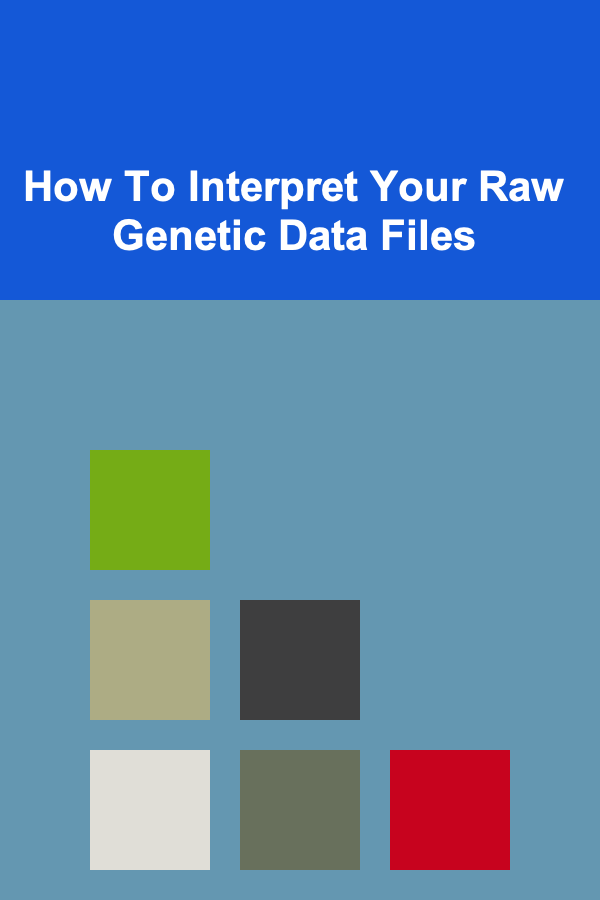
How To Interpret Your Raw Genetic Data Files
ebook include PDF & Audio bundle (Micro Guide)
$12.99$8.99
Limited Time Offer! Order within the next:

Genetic data, often obtained from direct-to-consumer genetic testing companies like 23andMe, AncestryDNA, or through clinical testing, can provide deep insights into your ancestry, health, and personal traits. These raw genetic data files are essentially a collection of your DNA sequences, encoded as letters (A, T, C, G), corresponding to your unique genetic makeup. However, interpreting these raw data files is not as straightforward as simply reading a report. In this article, we'll explore how to interpret your raw genetic data files, step by step, so you can better understand your genetic health, traits, and ancestry.
What Is a Raw Genetic Data File?
A raw genetic data file contains a sequence of your DNA information as a series of SNP (single nucleotide polymorphism) results. SNPs are variations in a single nucleotide (the basic building blocks of DNA). Each SNP represents a specific position in the genome where genetic variation occurs, and this variation may be linked to certain traits or health risks.
The data in these files typically appears as a string of numbers or letters indicating different SNPs, which you might then need to analyze in the context of your traits or health conditions. The raw data file can look overwhelming, but it's important to understand what's included and how to interpret it.
Types of Raw Genetic Data Files
When you download your raw genetic data from a testing company, it usually comes in a text file format, often with extensions such as .txt or .csv. The most common types of genetic files you will encounter include:
- 23andMe Raw Data File: Contains information about more than 700,000 SNPs, and is available for download through your 23andMe account settings.
- AncestryDNA Raw Data File: Similarly, this contains information about a variety of SNPs, but the exact number may differ.
- Raw Data from Other Direct-to-Consumer Tests: Companies like MyHeritage and FamilyTreeDNA also offer raw genetic data files, which may vary in content.
Structure of the Raw Genetic Data
While different companies may structure their files slightly differently, most will follow a basic format. The data is typically organized into columns with headers like:
- rsID: The unique identifier for a specific SNP.
- Chromosome: The chromosome on which the SNP is located (there are 22 autosomal chromosomes and two sex chromosomes: X and Y).
- Position: The position on the chromosome where the SNP is found.
- Genotype: The two alleles (variations of the gene) inherited from both parents. For example, you might have "AA," "AG," or "GG" as your genotype at a given SNP.
This data essentially represents a snapshot of your DNA, highlighting specific genetic markers that might be related to ancestry, traits, or health risks.
Why Interpret Your Raw Genetic Data?
Many people are curious about their raw genetic data for different reasons:
1. Health Insights
Understanding the genetic factors influencing health risks can help with early detection or prevention of certain conditions, such as heart disease, diabetes, and even some types of cancer. Many companies offer health reports, but these interpretations are general. By interpreting the raw data yourself, you can access even deeper insights into your health, particularly for conditions not included in the standard reports.
2. Ancestry Information
Your raw genetic data can also help trace your genetic ancestry more accurately than the ancestry reports provided by testing companies. By looking at the SNPs related to specific populations or regions, you can gather more granular insights into your ethnic background and genealogy.
3. Personal Traits
Some companies provide information on how your genes influence personal traits like eye color, sleep patterns, and lactose intolerance. By analyzing your raw data, you can expand your understanding of how your genetic makeup affects these traits.
4. Data Privacy
By analyzing your raw genetic data, you can understand exactly what is being shared and make informed decisions about how and with whom you share your data. This is especially important as genetic data can be highly sensitive and personal.
How to Interpret Your Raw Genetic Data
Interpreting your raw genetic data can seem daunting at first, but by breaking it down into digestible pieces, you can start to understand what your genetic makeup reveals about you. Below are the steps to help you interpret your genetic data.
Step 1: Download Your Raw Genetic Data
The first step is to download your raw genetic data from your testing service. Each company will have slightly different instructions, but typically, you'll find the option to download your raw data in the settings or account section of the website. Make sure to save the file to your computer for easy access.
Step 2: Open Your Raw Genetic Data File
Once downloaded, open the file with any text editor (like Notepad, Sublime Text, or a CSV viewer). The raw data will appear as a series of rows, each representing a unique SNP. You'll see columns for rsID, chromosome, position, and genotype.
Step 3: Identify the SNPs Relevant to Your Queries
There are thousands of SNPs in your genetic data, but not all of them are relevant to your specific interests (such as health or ancestry). To focus your interpretation, identify the SNPs that relate to the traits, health conditions, or ancestry regions you're interested in.
For instance, if you want to understand your predisposition to lactose intolerance, you can search for SNPs linked to this condition. Various scientific studies have identified SNPs associated with specific traits, diseases, or ethnic backgrounds.
Many websites and databases catalog the SNPs and the traits they influence, such as:
- SNPedia: A comprehensive database of SNP information where you can search for specific SNPs and see the associated traits, diseases, or conditions.
- GeneCards: A platform that provides detailed gene information, including which SNPs affect specific genes and their potential health implications.
- ClinVar: A resource that connects genetic variants to health-related conditions.
Step 4: Use Online Tools for Analysis
While manually interpreting the raw data is possible, it can be time-consuming and complicated. Fortunately, several online tools can help you analyze your genetic data and provide more user-friendly reports. Some of these tools include:
- Promethease: This tool generates a health report by comparing your raw genetic data with SNPedia's database. It offers detailed information about potential health risks associated with your genetic variants.
- Livewello: Another service that helps interpret genetic data with a focus on health, offering insights into specific conditions and traits.
- DNA.Land: This site allows you to upload your raw genetic data for ancestry analysis, providing insights into ethnic origins and family traits.
Step 5: Understand the Results
Once you've analyzed the data, you'll likely encounter terms like "genetic risk," "gene variants," or "alleles." Here's how to interpret these terms:
- Homozygous (AA, GG, etc.): This means that you have two identical alleles for a given SNP. For example, if the SNP in question is related to a health condition, being homozygous for a risk allele might indicate a higher likelihood of developing that condition.
- Heterozygous (AG, AT, etc.): You have one copy of the risk allele and one copy of the non-risk allele. In some cases, this might indicate a moderate risk compared to being homozygous for the risk allele.
- No Risk Alleles (TT, CC, etc.): If you don't carry the risk allele, you might not be predisposed to a specific condition, depending on the SNP.
It's important to remember that genetics is only part of the story. Environmental factors and lifestyle choices also play a significant role in determining your health outcomes.
Step 6: Consult with a Genetic Counselor or Healthcare Professional
While online tools and databases can help, interpreting your raw genetic data for health-related purposes is complex. If you're looking for deeper insights, it's recommended to consult with a genetic counselor or healthcare provider. They can help you understand the implications of certain SNPs and advise on any next steps, such as genetic testing for inherited diseases.
Ethical and Privacy Considerations
When working with your raw genetic data, it's crucial to understand the privacy implications. Genetic data is highly personal and should be treated with care. Be sure to read the privacy policies of any platform you upload your data to, and consider the risks of sharing your genetic information with third parties.
Additionally, it's important to be cautious when using third-party tools or databases to interpret your data. These services may store your genetic data or use it for research purposes, so always review their terms of service before submitting your raw data.
Conclusion
Interpreting your raw genetic data is an exciting and insightful way to learn more about your health, ancestry, and genetic traits. With the right tools and resources, you can explore your genetic makeup and gain a better understanding of your predispositions and origins. However, interpreting genetic data should be approached with caution, as it's a complex field. When in doubt, seek the advice of a professional to help you make informed decisions based on your genetic information.
By becoming familiar with your raw genetic data, you can unlock a wealth of information about yourself, empowering you to make informed choices about your health, lifestyle, and even family planning. Just remember, genetics is just one piece of the puzzle. The interplay between genetics, environment, and lifestyle ultimately shapes who you are.

How To Analyze the Director's Use of Cameos
Read More
How to Create a Festive Holiday Atmosphere on a Budget
Read More
How To Program Robots for Disaster Response
Read More
How to Take Care of Your Home's Foundation for Long-Term Stability
Read More
How to Use Wreaths to Decorate Your Home for Any Holiday Season
Read More
10 Tips for a DIY Window Seat Checklist: Cozy Comfort
Read MoreOther Products

How To Analyze the Director's Use of Cameos
Read More
How to Create a Festive Holiday Atmosphere on a Budget
Read More
How To Program Robots for Disaster Response
Read More
How to Take Care of Your Home's Foundation for Long-Term Stability
Read More
How to Use Wreaths to Decorate Your Home for Any Holiday Season
Read More